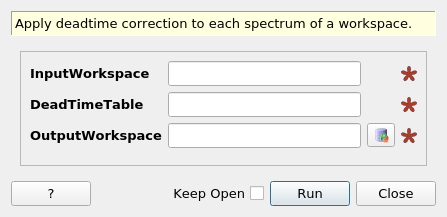\(\renewcommand\AA{\unicode{x212B}}\)
ApplyDeadTimeCorr v1¶

ApplyDeadTimeCorr dialog.¶
Summary¶
Apply deadtime correction to each spectrum of a workspace.
See Also¶
Properties¶
Name |
Direction |
Type |
Default |
Description |
|---|---|---|---|---|
InputWorkspace |
Input |
Mandatory |
The name of the input workspace containing measured counts |
|
DeadTimeTable |
Input |
Mandatory |
Name of the Dead Time Table |
|
OutputWorkspace |
Output |
Mandatory |
The name of the output workspace containing corrected counts |
Description¶
Assuming that the InputWorkspace contains measured counts as a function of time, the algorithm returns a workspace containing true counts as a function of the same time binning according to
where
DeadTimeTable is expected to have 2 columns:
Integer type, containing spectrum number (not index)
Double type, containing \(t_{\mathrm{dead}}\) value of the spectrum
It is assumed that all bins in the InputWorkspace are the same size (to within reasonable rounding error). If they are not, the algorithm will exit with an error.
The InputWorkspace must contain a sample log goodfrm (number of good frames) for the algorithm to run successfully.
Usage¶
Note
To run these usage examples please first download the usage data, and add these to your path. In Mantid this is done using Manage User Directories.
Example - Applying the correction using custom dead times:
# Load single period of a MUSR run
input = LoadMuonNexus('MUSR0015189.nxs', EntryNumber=1)
# Remove uninteresting bins
input = CropWorkspace('input', XMin=0.55, XMax=12)
# Create a table with some arbitrary dead times
dead_times = CreateEmptyTableWorkspace()
dead_times.addColumn('int', 'Spectrum no.')
dead_times.addColumn('double', 'Deadtime')
for i in range(1,65):
dead_times.addRow([i, 0.1])
output = ApplyDeadTimeCorr('input','dead_times')
original = Integration('input')
corrected = Integration('output')
format_str = 'Spectrum: {0:d}; original: {1:.3f}; corrected: {2:.3f}'
for s in [0,32,63]:
print(format_str.format(s, original.readY(s)[0], corrected.readY(s)[0]))
Output:
Spectrum: 0; original: 6643.000; corrected: 7100.833
Spectrum: 32; original: 10384.000; corrected: 11559.134
Spectrum: 63; original: 8875.000; corrected: 9724.937
Example - Applying the correction using dead times stored in the Nexus file:
# Load a MUSR run
input = LoadMuonNexus('MUSR0015189.nxs', DeadTimeTable='dead_times')
# Remove uninteresting bins
input = CropWorkspace('input', XMin=0.55, XMax=12)
# Apply the loaded dead times
output = ApplyDeadTimeCorr('input','dead_times')
original = Integration(input.getItem(0))
corrected = Integration(output.getItem(0))
format_str = 'Spectrum: {0:d}; original: {1:.3f}; corrected: {2:.3f}'
for s in [0,32,63]:
print(format_str.format(s, original.readY(s)[0], corrected.readY(s)[0]))
Output:
Spectrum: 0; original: 6643.000; corrected: 6697.453
Spectrum: 32; original: 10384.000; corrected: 10520.529
Spectrum: 63; original: 8875.000; corrected: 8969.891
Categories: AlgorithmIndex | Muon | CorrectionFunctions\EfficiencyCorrections
Source¶
C++ header: ApplyDeadTimeCorr.h
C++ source: ApplyDeadTimeCorr.cpp
